The Application of Ontologies in Multi-Agent Systems in the Energy Sector: A Scoping Review
Abstract
1. Introduction
2. Method
3. Results
3.1. Definition of Agent and MAS
3.1.1. Agent and Agent-Based Modeling
- It has the ability to communicate and interact with its environment;
- It is able to perceive the (local) environment;
- It is guided by basic objectives;
- It has feedback behavior.
3.1.2. Multi-Agent Systems
- Large numbers of actors are able to interact, in competition or in cooperation;
- Local agents focusing on local interests and negotiating with more global agents;
- Implementation of distributed decision making, through negotiation processes between different local or global agents;
- Communication between actors is minimized to generic information exchange between agents: only the information necessary for their functioning is sent between agents.
3.2. MAS Applied in Energy Domains
3.2.1. MAS for Grid Control
3.2.2. MAS for Electricity Markets
3.2.3. MAS for Demand-Side and Building Systems
3.2.4. MAS Tools for the Energy Domain
- Multi-agent simulators for smart grid:
- Mosaik (https://mosaik.offis.de/): [49,50] is a flexible smart grid co-simulation framework, and allows to reuse and combine existing simulation models and simulators to create large-scale smart grid scenarios [63]
- MASGriP (Multi-Agents Smart Grid Simulation Platform): models the internal operation of a smart grid with the consideration of all involved players [21].
- Multi-agent simulators for the grid communication, monitoring, and control:
- Electric Power and Communication Synchronizing Simulator (EPOCHS) (http://www.cs.cornell.edu/hopkik/epochs.htm): aims to solve network communication problems and avoid potential costs and damages by the combination of the results of several simulators [64].
- Global Event-Driven Co-Simulation framework (GECO): models and simulates the control, monitoring, and protection of the power systems and communication network [65].
- Multi-agent simulators for electricity markets:
- Multi-Agent Simulator for Electricity Markets (MASCEM) (http://www.mascem.gecad.isep.ipp.pt/overview.php/): can simulate many market models and player types, and enable decision-support [21].
- Agent-based Modeling of Electricity Systems (AMES) (http://www2.econ.iastate.edu/tesfatsi/AMESMarketHome.htm): simulates wholesale power market operation including load, market participants, grid [66].
- Power Trading Agent Competition (Power TAC) (https://powertac.org/): is an open-source platform that simulates future electricity market including broker types of energy retailers, commercial or municipal utilities, or cooperatives [67].
- Electricity Market Complex Adaptive System (EMCAS) (https://ceeesa.es.anl.gov/projects/emcas.html): simulates diverse participants’ strategies and behaviors in the electricity market [68]
- Multi-Agent Negotiation and Risk Management in Electricity Markets (MAN-REM): simulates electricity markets, and emphases the bilateral contracting and risk management [37].
- Adaptive Learning strategic Bidding System (ALBidS): aims to integrate market strategies, evaluate performances under different contexts of negotiation, and provides decision support to electricity markets negotiating players [69].
3.3. Ontology and Defined Ontologies in the Energy Domain
3.3.1. Definition of Ontology
- Communication between people. Here, an unambiguous but informal ontology may be sufficient.
- Inter-operability among systems achieved by translating between different modeling methods, paradigms, languages and software tools;
- Communication: ontology can provide common glossaries to communication among different individuals.
- Interoperation: ontology can freely interpret and map among various modeling methods, languages and software tools.
- Reuse: the ontology’s analyses clarify the structure of the field’s knowledge in order to lay a good foundation for knowledge representation. Ontology can be reused, so the repetitious knowledge analyses can be avoided.
- Knowledge acquisition and sharing: to construct the system based on knowledge, the available ontology can be used as origination and foundation to supervise the acquisition of knowledge, which can improve its velocity and reliability.
3.3.2. Defined Ontologies in the Energy Domain
- Cognitive ontology: the activity that agents analyze power systems.
- Physical entity ontology: the equipment that is used for transmitting electric energy and its connecting topology.
- Data ontology: the magnitude that cognitive agent has apperceived to respond to physical entities.
- State ontology: the generalization of the current operation mode in an electric power grid.
- Event ontology: all aspects that create changes of state.
- Operation Ontology: the combination of all actual actions that a cognitive agent does on physical entities.
3.3.3. Ontology Design
- Categories of ontologies
- Ontology mapping
- Ontology development tools
- Ontology development process
- Step 1.
- Determine the domain and scope of the ontology
- Step 2.
- Consider reusing existing ontologies
- Step 3.
- Enumerate important terms in the ontology
- Step 4.
- Define the classes and the class hierarchy
- Step 5.
- Define the properties of classes—slots
- Step 6.
- Define the facets of the slots
- Step 7.
- Create instances
3.4. MAS Design and Architectures
3.4.1. MAS Design Methodologies
- (1)
- A conceptualization phase where the problem to be solved is specified;
- (2)
- An analysis phase;
- (3)
- A design phase that uses the results of the analysis phase to produce agent designs of varying detail
- Requirements and knowledge capture stage: the MAS design usually begins with a particular problem. To solve this problem, this stage specifies the system requirements and capture the knowledge needed to fulfill those requirements. The system requirements and captured knowledge is the input to the next stage.
- Task decomposition stage: it transforms the requirements specification and captured knowledge from the previous stage into a hierarchy of tasks and subtasks. These tasks may include the functions performed by legacy systems.
- Ontology design
- Agent modeling stage: based on the task hierarchy and ontology design, it identifies a group of autonomous agents performing the tasks in the task hierarchy. Each task in the hierarchy must be attributed to at least one agent and one agent can encapsulate one or more tasks. The outcome is a set of agent models that specify the tasks the agents perform. The tasks attributed to legacy systems and generated new codes are also identified at this stage.
- Agent interaction modeling stage: it defines the interactions the identified agents support. The output usually is the interaction diagrams.
- Specification of agent behaviors stage: it specifies the interaction functionality of the agent and the control functionality of the agent.
- MAS Development environment
3.4.2. MAS Architectures
- Agent types
- Agent management framework/ system architecture
3.5. The Application of Ontology in MAS Development
3.5.1. MAS Interoperability and Ontology
3.5.2. Agent Communication and Ontology
- Standards for agent communication and interoperability
- Ontology-based agent communication design
4. Discussion
5. Conclusions
- Definition of agent and MAS. The definitions of agent, intelligent agent and MAS and the introduction of an agent structure are given in some selected publication. However, some publications do not differentiate the agent-based system and multi-agent-based systems.
- MAS applied energy domains. The applied energy domains include grid control (also, microgrids), electricity markets, demand-side and building systems. The applied MAS tools are also introduced in some selected publication.
- Defined ontologies in the energy domain. Definition of ontology, functions of ontology and the defined ontologies in the energy domain are introduced. The ontology design is introduced usually together with the agent communication model. Although generic ontology and the case-specific ontology, upper-level, and lower-level ontology, and ontology hierarchical are introduced, a systematic discussion on the categories of ontologies (upper ontologies, domain ontologies, and application ontology) is missing. Meanwhile, although ontology mapping for inter-MAS communication and ontology development tools are introduced, the ontology development process is not yet discussed in the selected literature.
- MAS Design and architectures. The MAS design methodology-Gaia methodology is introduced and applied in some selected publication, and MAS design methodology proposed by the IEEE PES MAS working group is introduced but not well discussed or applied in the selected publication. The MAS Development environment, JADE, and its extensions are introduced but the design detail with JADE is missing. The MAS architecture is commonly introduced with the description of agent types and agent management framework/ system architecture.
- Ontology in the MAS development. The importance of ontology for the MAS interoperability is emphasized and the application of ontology in the agent communication design is well discussed in the majority of the selected publication. The standards for agent communication and interoperability are discussed with two dimensions: standards for domain-specific, e.g., the SGAM reference model, the power systems CIM and SEAS knowledge model in the energy domain are discussed; The FIPA-ACL is applied for almost all MAS design in the selected publication.
5.1. Recommendation of the Ontology-Driven MAS Development for the Energy Domain
- The ontology development process in MAS design
- The detail design process and realization of the ontology-driven MAS development
- Open standard implementation and adoption
- Higher intelligent MAS development
- Inter-domain MAS development
- Agent listing
5.2. Limitations and Future Work
Author Contributions
Funding
Conflicts of Interest
Appendix A
| Year | Title | Reference | Focused Aspect | ||
|---|---|---|---|---|---|
| Energy Domain | Ontology | MAS Design | |||
| 2004 | A policy-driven multi-agent system for OGSA-compliant grid control | [124] | Grid control | Policy ontology Application-specific ontology | Agent type Agent logics |
| 2005 | Issues in integrating existing multi-agent systems for power engineering applications | [91] | Grid control | Upper ontology Ontology mapping | Inter-MAS communication, Interoperability |
| 2006 | Modeling energy and transport infrastructures as a multi-agent system using a generic ontology | [14] | Grid control | Generic and case-specific ontologies | ABM |
| 2007 | Multi-agent architecture of energy management system based on IEC 61970 CIM | [13] | Management system | IEC 61970 Standard | Agent structure MAS architecture Multi-agent communication |
| 2009 | Multi-agents for energy efficient comfort agents for the energy infrastructure of the built environment: Flexergy | [51] | Buildings/demand side | Ontology for the design process | Agent type |
| 2011 | Intelligent multi-agent framework for power system control and protection | [20] | Grid control | Ontology structure | Agent type Agent logics MAS architecture UML diagrams |
| 2011 | Multi-agent system for self-optimizing power distribution grids | [15] | Grid control | Domain ontology in the world model | Agent type World model |
| 2013 | An architecture for a microgrid-based eco industrial park using a Multi-Agent System | [17] | Microgrid | Ontology in the agent design process | Agent types Agent logics MAS architecture, Negotiation methodology |
| 2013 | Demonstration of a multi-agent-based control system for active electric power distribution grids | [23] | Grid control | An ontology with four levels | Agent type MAS architecture |
| 2013 | Power transformer condition monitoring and fault diagnosis with multi-agent system based on ontology reasoning | [24] | Grid control | Ontology reasoning | MAS architecture |
| 2013 | Upper ontology for multi-agent energy systems’ applications | [21] | Power system | Upper ontology and standards | Agent types MAS interoperability |
| 2013 | Smart grid - building energy management system: an ontology multi-agent approach to optimize comfort demand and energy supply | [16] | Buildings/demand side | Ontology hierarchical | Agent UML diagrams |
| 2014 | Energy efficient automation model for office buildings based on ontology, agents and IEC 61499 function blocks | [53] | Buildings/demand side | Translator agent and ontology agent | Agent type Agent logics |
| 2014 | Realistic multi-agent simulation of competitive electricity markets | [37] | Electricity market | Upper ontology | Agent types MAS interoperability |
| 2015 | Multi-agent simulation of competitive electricity markets: Autonomous systems cooperation for European market modeling | [49] | Electricity market | Upper ontology | MAS interoperability and UML diagrams |
| 2016 | Optimal real-time dispatch for integrated energy systems: an ontology-based multi-agent approach | [52] | Grid control | Ontology-based FIPA-ACL | Agent type Communication architecture |
| 2016 | Ontology-based demand-side flexibility management in smart grids using a multi-agent system | [50] | Buildings/demand side | Standard of data models in the power system | Gaia methodology |
| 2016 | An ontology-driven approach for modeling a multi-agent-based electricity market | [81] | Electricity market | Ontology-Driven Conceptual Modelling | Model-driven development MAS organizational structure |
| 2016 | Enabling communications in heterogeneous multi-agent systems: electricity markets ontology | [48] | Electricity market | Electricity Markets OntologyDescription logic | MAS interoperability |
| 2017 | A multi-agent-based energy management solution for integrated buildings and microgrid system | [8] | Management systemMicrogrid Buildings/demand side | Ontology for message content | Agent types Agent goals, MAS architecture |
| 2017 | EPEX ontology: enhancing agent-based electricity market simulation | [3] | Electricity market | Lower ontology | MAS interoperability |
| 2017 | Nord Pool ontology to enhance electricity markets simulation in MASCEM | [47] | Electricity market | Lower ontology | MAS interoperability |
| 2018 | Power systems simulation using ontologies to enable the interoperability of multi-agent systems | [38] | Power system | SEAS knowledge model | MAS interoperability |
| 2018 | Multi-agent decision support tool to enable interoperability among heterogeneous energy systems | [9] | Power systemMicrogrid | Ontology in Tools Control Center (TOOCC) framework | MAS interoperability |
References
- Koritarov, V.S. Real-world market representation with agents. IEEE Power Eng. Mag. 2004, 2, 39–46. [Google Scholar] [CrossRef]
- Wüstenhagen, R.; Menichetti, E. Strategic choices for renewable energy investment: Conceptual framework and opportunities for further research. Energy Policy 2012, 40, 1–10. [Google Scholar] [CrossRef]
- Santos, G.; Pinto, T.; Praca, I.; Vale, Z. EPEX Ontology: Enhancing Agent-Based Electricity Market Simulation. In Proceedings of the 2017 19th International Conference on Intelligent System Application to Power Systems (ISAP), San Antonio, TX, USA, 17–20 September 2017; pp. 1–6. [Google Scholar]
- Lamparter, S.; Ankolekar, A.; Oberle, D.; Studer, R.; Weinhardt, C. Semantic specification and evaluation of bids in web-based markets. Electron. Commer. Res. Appl. 2008, 7, 313–329. [Google Scholar] [CrossRef]
- Yang, S.-Y. Developing an energy-saving and case-based reasoning information agent with Web service and ontology techniques. Expert Syst. Appl. 2013, 40, 3351–3369. [Google Scholar] [CrossRef]
- Zhou, Z.; Chan, W.K.; Chow, J.H. Agent-based simulation of electricity markets: A survey of tools. Artif. Intell. Rev. 2007, 28, 305–342. [Google Scholar] [CrossRef]
- Mays, N.; Pope, C.; Popay, J. Systematically reviewing qualitative and quantitative evidence to inform management and policy-making in the health field. J. Health Serv. Res. Policy 2005, 10, 6–20. [Google Scholar] [CrossRef]
- Anvari-Moghaddam, A.; Rahimi-Kian, A.; Mirian, M.S.; Guerrero, J.M. A multi-agent based energy management solution for integrated buildings and microgrid system. Appl. Energy 2017, 203, 41–56. (In English) [Google Scholar] [CrossRef]
- Teixeira, B.; Pinto, T.; Silva, F.; Santos, G.; Praca, I.; Vale, Z. Multi-Agent Decision Support Tool to Enable Interoperability among Heterogeneous Energy Systems. Appl. Sci. Basel 2018, 8, 328. [Google Scholar] [CrossRef]
- Van der Hoek, W.; Wooldridge, M. Chapter 24 Multi-Agent Systems. In Foundations of Artificial Intelligence; van Harmelen, F., Lifschitz, V., Porter, B., Eds.; Elsevier: Amsterdam, The Netherlands, 2008; Volume 3, pp. 887–928. [Google Scholar]
- Wooldridge, M.; Jennings, N.R. Intelligent agents: Theory and practice. Knowl. Eng. Rev. 1995, 10, 115–152. [Google Scholar] [CrossRef]
- Russell, S.J.; Norvig, P. Artificial Intelligence: A Modern Approach; Pearson Education: London, UK, 2003; p. 1132. [Google Scholar]
- Song, W.; Wang, X.; Cao, H.; Pan, G. Multi-Agent Architecture of Energy Management System Based on IEC 61970 CIM. In Proceedings of the 2007 International Power Engineering Conference (IPEC 2007), Singapore, 3–6 Decemeber 2007; pp. 1366–1370. [Google Scholar]
- Van Dam, K.H.; Lukszo, Z. Modelling Energy and Transport Infrastructures as a Multi-Agent System Using a Generic Ontology. In Proceedings of the 2006 IEEE International Conference on Systems, Man and Cybernetics, Taipei, Taiwan, 8–11 October 2006; Volume 1, pp. 890–895. [Google Scholar]
- Merdan, M.; Lepuschitz, W.; Strasser, T.; Andren, F. Multi-Agent System for Self-Optimizing Power Distribution Grids. In Proceedings of the 5th International Conference on Automation, Robotics and Applications, Wellington, New Zealand, 6–8 December 2011; pp. 312–317. [Google Scholar]
- Zeiler, W.; Boxem, G. Smart Grid—Building Energy Management System: An Ontology Multi-agent Approach to Optimize Comfort Demand and Energy Supply. ASHRAE Trans. 2013, 119, 1–8. [Google Scholar]
- Mert, B.; Aradag, U.; Uludag, S.; Unver, H.O. An Architecture for a Microgrid-Based Eco Industrial Park Using a Multi-Agent System. In Proceedings of the 4th International Conference on Power Engineering, Energy and Electrical Drives, Istanbul, Turkey, 13–17 May 2013; pp. 1658–1664. [Google Scholar]
- McArthur, S.D.; Davidson, E.M.; Catterson, V.M.; Dimeas, A.L.; Hatziargyriou, N.D.; Ponci, F.; Funabashi, T. Multi-Agent Systems for Power Engineering Applications—Part I: Concepts, Approaches, and Technical Challenges. IEEE Trans. Power Syst. 2007, 22, 1743–1752. [Google Scholar] [CrossRef]
- Jennings, N.R.; Bussmann, S. Agent-based control systems: Why are they suited to engineering complex systems? IEEE Control. Syst. Mag. 2003, 23, 61–73. [Google Scholar]
- Manickam, A.; Kamalasadan, S.; Edwards, D.; Simmons, S. Intelligent Multi-Agent Framework for Power System Control and Protection. In Proceedings of the 2011 IEEE Power and Energy Society General Meeting, San Diego, CA, USA, 24–29 July 2011; pp. 1–8. [Google Scholar]
- Santos, G.; Pinto, T.; Vale, Z.; Morais, H.; Praça, I. Upper Ontology for Multi-Agent Energy Systems’ Applications; Springer International Publishing: Berlin, Germany, 2013; pp. 617–624. [Google Scholar]
- Honold, J.; Kandler, C.; Wimmer, P.; Schropp, B.; Reichle, R.; Gröne, M.; Bünemann, M.; Klein, J.; Kufner, M. Distributed integrated energy management systems in residential buildings. Appl. Therm. Eng. 2017, 114, 1468–1475. [Google Scholar] [CrossRef]
- Prostejovsky, A.; Merdan, M.; Schitter, G.; Dimeas, A. Demonstration of a Multi-Agent-Based Control System for Active Electric Power Distribution Grids. In Proceedings of the 2013 IEEE International Workshop on Inteligent Energy Systems (IWIES), Vienna, Austria, 14 November 2013; pp. 76–81. [Google Scholar]
- Samirmi, F.D.; Tang, W.; Wu, H. Power Transformer Condition Monitoring and Fault Diagnosis with Multi-Agent System Based on Ontology Reasoning. In Proceedings of the 2013 IEEE PES Asia-Pacific Power and Energy Engineering Conference (APPEEC), Kowloon, China, 8–11 December 2013; pp. 1–6. [Google Scholar]
- Chouhan, S.; Wan, H.; Lai, H.J.; Feliachi, A.; Choudhry, M.A. Intelligent Reconfiguration of Smart Distribution Network Using Multi-Agent Technology. In Proceedings of the 2009 IEEE Power & Energy Society General Meeting, Calgary, AB, Canada, 26–30 July 2009; pp. 1–6. [Google Scholar]
- Zhang, W.; Xu, Y.; Liu, W.; Zang, C.; Yu, H. Distributed Online Optimal Energy Management for Smart Grids. IEEE Trans. Ind. Inform. 2015, 11, 717–727. [Google Scholar] [CrossRef]
- Pournaras, E.; Vasirani, M.; Kooij, R.E.; Aberer, K. Decentralized Planning of Energy Demand for the Management of Robustness and Discomfort. IEEE Trans. Ind. Inform. 2014, 10, 2280–2289. [Google Scholar] [CrossRef]
- Wang, C. Analysis of Eco-Industrial Park Supporting System on Industrial Symbiosis. In Proceedings of the 2011 IEEE 18th International Conference on Industrial Engineering and Engineering Management, Changchun, China, 3–5 September 2011; Volume 2, pp. 1337–1339. [Google Scholar]
- National Institute of Standards and Technology. NIST Framework and Roadmap for Smart Grid Interoperability Standards, Release 3.0, U.S. Department of Commerce 2014. Available online: https://www.nist.gov/publications/nist-framework-and-roadmap-smart-grid-interoperability-standards-release-30 (accessed on 25 July 2019).
- Morozumi, S. Micro-Grid Demonstration Projects in Japan. In Proceedings of the 2007 Power Conversion Conference—Nagoya, Nagoya, Japan, 2–5 April 2007; pp. 635–642. [Google Scholar]
- Lopes, J.A.P.; Moreira, C.L.; Madureira, A.G. Defining control strategies for MicroGrids islanded operation. IEEE Trans. Power Syst. 2006, 21, 916–924. [Google Scholar] [CrossRef]
- Zhao, B.; Zhang, X.; Chen, J. Integrated Microgrid Laboratory System. IEEE Trans. Power Syst. 2012, 27, 2175–2185. [Google Scholar] [CrossRef]
- Dimeas, A.L.; Hatziargyriou, N.D. Operation of a multiagent system for microgrid control. IEEE Trans. Power Syst. 2005, 20, 1447–1455. [Google Scholar] [CrossRef]
- Pipattanasomporn, M.; Rahman, S. Intelligent Distributed Autonomous Power Systems (IDAPS) and Their Impact on Critical Electrical Loads. In Proceedings of the First IEEE International Workshop on Critical Infrastructure Protection (IWCIP’05), Darmstadt, Germany, 3–4 November 2005; p. 9. [Google Scholar]
- Khan, A.; Giraud-Audine, C.; Bigot, R.; Abba, G.; Abideen, M.Z. An alternative explanation of forming force reduction for forming process submitted to vibration: Influence of the waveform in the viscoplastic domain. J. Mater. Process. Technol. 2016, 230, 288–299. [Google Scholar] [CrossRef]
- Zhu, Z.; Lambotharan, S.; Chin, W.H.; Fan, Z. A Game Theoretic Optimization Framework for Home Demand Management Incorporating Local Energy Resources. IEEE Trans. Ind. Inform. 2015, 11, 353–362. [Google Scholar] [CrossRef]
- Pinto, T.; Santos, G.; Vale, Z.; Praça, I.; Lopes, F.; Algarvio, H. Realistic Multi-Agent Simulation of Competitive Electricity Markets. In Proceedings of the 25th International Workshop on Database and Expert Systems Applications, Munich, Germany, 1–5 September 2014; pp. 109–113. [Google Scholar]
- Santos, G.; Silva, F.; Teixeira, B.; Vale, Z.; Pinto, T. Power Systems Simulation Using Ontologies to Enable the Interoperability of Multi-Agent Systems. In Proceedings of the 2018 Power Systems Computation Conference (PSCC), Dublin, Ireland, 11–15 June 2018; pp. 1–7. [Google Scholar]
- Li, H. Development of Open Source Software for Power Market Research: An Illustrative Case Study. J. En. Mark. 2009, 2, 111. [Google Scholar]
- Veselka, T.; Boyd, G.; Conzelmann, G.; Koritarov, V.; Macal, C.; North, M.; Schoepfle, B.; Thimmapuram, P. Simulating the behavior of electricity markets with an agent-based methodology: The Electric Market Complex Adaptive Systems (EMCAS) model. In Proceedings of the USAEE Conference, United States Association for Energy Economic, Houston, TX, USA, 25–27 April 2001. [Google Scholar]
- Conzelmann, G.; Boyd, G.; Koritarov, V.; Veselka, T. Multi-Agent Power Market Simulation Using EMCAS. In Proceedings of the IEEE Power Engineering Society General Meeting, San Francisco, CA, USA, 16 June 2005; pp. 2829–2834. [Google Scholar]
- Praca, I.; Ramos, C.; Vale, Z.; Cordeiro, M. MASCEM: A multiagent system that simulates competitive electricity markets. IEEE Intell. Syst. 2003, 18, 54–60. [Google Scholar] [CrossRef]
- Praça, I.; Ramos, C.; Vale, Z. Multi-Agent Simulation of Electricity Markets. In Proceedings of the 2nd Workshop Agent-Based Simulation, Boston, MA, USA, July 2000; pp. 89–94. [Google Scholar]
- Vale, Z.; Pinto, T.; Praca, I.; Morais, H. MASCEM: Electricity Markets Simulation with Strategic Agents. IEEE Intell. Syst. 2011, 26, 9–17. [Google Scholar] [CrossRef]
- Von Neumann, J.; Morgenstern, O. Theory of Games and Economic Behavior; Princeton University Press: Princeton, NJ, USA, 2007. [Google Scholar]
- Praça, I.; Ramos, C.; Vale, Z.; Cordeiro, M. Intelligent agents for negotiation and game-based decision support in electricity markets. Eng. Intell. Syst. Electr. Eng. Commun. 2005, 13, 147. [Google Scholar]
- Santos, G.; Pinto, T.; Praça, I.; Vale, Z. Nord Pool Ontology to Enhance Electricity Markets Simulation in MASCEM. In Proceedings of the EPIA Conference on Artificial Intelligence, Porto, Portugal, 5–8 September 2017; Volume 10423, pp. 283–294. [Google Scholar]
- Santos, G.; Pinto, T.; Vale, Z.; PraÇA, I.; Morais, H. Enabling Communications in Heterogeneous Multi-Agent Systems: Electricity Markets Ontology. ADCAIJ Adv. Distrib. Comput. Artif. Intell. J. 2016, 5, 15–42. (In English) [Google Scholar] [CrossRef][Green Version]
- Santos, G.; Pinto, T.; Morais, H.; Sousa, T.M.; Pereira, I.F.; Fernandes, R.; Praça, I.; Vale, Z. Multi-agent simulation of competitive electricity markets: Autonomous systems cooperation for European market modeling. Energy Convers. Manag. 2015, 99, 387–399. (In English) [Google Scholar] [CrossRef]
- Hippolyte, J.L.; Howell, S.; Yuce, B.; Mourshed, M.; Sleiman, H.A.; Vinyals, M.; Vanhée, L. Ontology-Based Demand-Side Flexibility Management in Smart Grids Using a Multi-Agent System. In Proceedings of the 2016 IEEE International Smart Cities Conference (ISC2), Trento, Italy, 12–15 September 2016; pp. 1–7. [Google Scholar]
- Zeiler, W.; van Houten, R.; Boxem, G.; van der Velden, J.; Wortel, W.; Haan, J.F.; Noom, P.; Kamphuis, R.; Hommelberg, M.; Broekhuizen, H. Multi-Agents For Energy Efficient Comfort Agents for the Energy Infrastructure of the Built Environment: Flexergy. In Proceedings of the International Conference on Agents and Artificial Intelligence, Icaart 2009, Porto, Portugal, 19–21 January 2009; pp. 579–586. [Google Scholar]
- Anvari-Moghaddam, A.; Guerrero, J.M.; Rahimi-Kian, A.; Mirian, M.S. Optimal Real-Time Dispatch for Integrated Energy Systems: An Ontology-Based Multi-Agent Approach. In Proceedings of the IEEE Conferences, Vancouver, BC, Canada, 27–30 June 2016; pp. 1–7. [Google Scholar]
- Mousavi, A.; Yang, C.; Pang, C.; Vyatkin, V. Energy Efficient Automation Model for Office Buildings Based on Ontology, Agents and IEC 61499 Function Blocks. In Proceedings of the 2014 IEEE Emerging Technology and Factory Automation (ETFA), Barcelona, Spain, 16–19 September 2014; pp. 1–7. [Google Scholar]
- Joyrama, H. A critical evaluation on the factors impacting the adoption of eco-block as a green construction material: From a Mauritian perspective. J. Build. Eng. 2019, 5, 100789. [Google Scholar] [CrossRef]
- Berardi, U. A cross-country comparison of the building energy consumptions and their trends. Resour. Conserv. Recycl. 2017, 123, 230–241. [Google Scholar] [CrossRef]
- Goyal, S.; Wang, W.; Brambley, M.R. Design and implementation of a test bed for building controls. Build. Serv. Eng. Res. 2019. [Google Scholar] [CrossRef]
- Rutishauser, U.; Joller, J.; Douglas, R. Control and learning of ambience by an intelligent building. IEEE Trans. Syst. Man Cybern. Part A Syst.Hum. 2005, 35, 121–132. [Google Scholar] [CrossRef]
- Biermann, J.; Corubolo, F.; Eggers, A.; Waddington, S. An Ontology Supporting Planning, Analysis, and Simulation of Evolving Digital Ecosystems. In Proceedings of the 8th International ACM Conference on Management of Digital EcoSystems, Hendaye, France, 2–4 November 2016; pp. 26–33. [Google Scholar]
- Georgievski, I.; Degeler, V.; Pagani, G.A.; Nguyen, T.A.; Lazovik, A.; Aiello, M. Optimizing Offices for the Smart Grid; Institute for Mathematics and Computer Science University of Groningen: Gorningen, The Netherlands, 2011. [Google Scholar]
- Lewis, R. Modelling Control Systems Using IEC 61499: Applying Function Blocks to Distributed Systems; The Institution of Engineering and Technology: London, UK, 2001. [Google Scholar]
- Lavbič, D.; Vasilecas, O.; Rupnik, R. Ontology-based multi-agent system to support business users and management. Technol. Econ. Dev. Econ. 2010, 16, 327–347. [Google Scholar] [CrossRef][Green Version]
- Kahn, M.L.; Cicalese, C.D. The CoABS Grid; Springer: Berlin, Germany, 2003; pp. 125–134. [Google Scholar]
- Steinbrink, C.; Blank-Babazadeh, M.; El-Ama, A.; Holly, S.; Lüers, B.; Nebel-Wenner, M.; Ramírez Acosta, R.P.; Raub, T.; Schwarz, J.S.; Stark, S.; et al. CPES Testing with mosaik: Co-Simulation Planning, Execution and Analysis. Appl. Sci. 2019, 9, 923. [Google Scholar] [CrossRef]
- Hopkinson, K.; Xiaoru, W.; Giovanini, R.; Thorp, J.; Birman, K.; Coury, D. EPOCHS: A platform for agent-based electric power and communication simulation built from commercial off-the-shelf components. IEEE Trans. Power Syst. 2006, 21, 548–558. [Google Scholar] [CrossRef]
- Lin, H.; Veda, S.S.; Shukla, S.S.; Mili, L.; Thorp, J. GECO: Global Event-Driven Co-Simulation Framework for Interconnected Power System and Communication Network. IEEE Trans. Smart Grid 2012, 3, 1444–1456. [Google Scholar] [CrossRef]
- Sun, J.; Tesfatsion, L. An Agent-Based Computational Laboratory for Wholesale Power Market Design. In Proceedings of the 2007 IEEE Power Engineering Society General Meeting, Tampa, FL, USA, 24–28 June 2007; pp. 1–6. [Google Scholar]
- Babic, J.; Podobnik, V. An Analysis of Power Trading Agent Competition; Springer International Publishing: Cham, Switzerland, 2014; pp. 1–15. [Google Scholar]
- Center for Energy Environmental and Economic Systems Analysis. “Electricity Market Complex Adaptive System (EMCAS)”, Argonne National Laboratory, Argonne, USA. 2008. Available online: https://ceeesa.es.anl.gov/pubs/61084.pdf (accessed on 20 August 2019).
- Pinto, T.; Vale, Z.; Praça, I.; Santos, G. Demonstration of ALBidS: Adaptive Learning Strategic Bidding System; Springer International Publishing: Cham, Switzerland, 2016; pp. 281–285. [Google Scholar]
- Busse, J.; Humm, B.G.; Lübbert, C.; Moelter, F.; Reibold, A.; Rewald, M.; Schlüter, V.; Seiler, B.; Tegtmeier, E.; Zeh, T. Actually, what does “ontology” mean? J. Comput. Inf. Technol. 2015, 23, 29–41. [Google Scholar] [CrossRef]
- Berners-Lee, T.; Hendler, J.; Lassila, O. The Semantic Web. Sci. Am. 2001, 284, 28–37. [Google Scholar] [CrossRef]
- Maedche, A.; Staab, S. Ontology Learning for the Semantic Web. IEEE Intell Syst. 2001, 16, 72–79. [Google Scholar]
- Gruber, T.R. A translation approach to portable ontology specifications. Knowl. Acquis. 1993, 5, 199–220. [Google Scholar] [CrossRef]
- Dillon, T.S.; Chang, E.; Hadzic, M.; Wongthongtham, P. Differentiating Conceptual Modelling from Data Modelling, Knowledge Modelling and Ontology Modelling and a Notation for Ontology Modelling. APCCM 2008, 8, 7–17. [Google Scholar]
- Uschold, M. Knowledge level modelling: Concepts and terminology. Knowl. Eng. Rev. 1998, 13, 5–29. [Google Scholar] [CrossRef]
- Noy, N.F.; McGuinness, D.L. Ontology Development 101: A Guide to Creating Your First Ontology. Stanford University, Stanford. 2001. Available online: https://protege.stanford.edu/publications/ontology_development/ontology101-noy-mcguinness.html (accessed on August 2019).
- Huang, J.; Dou, D.; He, L.; Hayes, P.; Dang, J. Ontology-Based Knowledge Discovery and Sharing in Bioinformatics and Medical Informatics: A Brief Survey. In Proceedings of the 2010 Seventh International Conference on Fuzzy Systems and Knowledge Discovery, Yantai, China, 10–12 August 2010; Volume 5, pp. 2203–2208. [Google Scholar]
- Kim, S. Implementation of Web Ontology for Semantic Web Application. In Proceedings of the Sixth International Conference on Advanced Language Processing and Web Information Technology (ALPIT 2007), Luoyang, Henan, China, 22–24 August 2007; pp. 159–164. [Google Scholar]
- Tran, T.; Lewen, H.; Haase, P. On the Role and Application of Ontologies in Information Systems. In Proceedings of the 2007 IEEE International Conference on Research, Innovation and Vision for the Future, Hanoi, Vietnam, 5–9 March 2007; pp. 14–21. [Google Scholar]
- Wang, X.H.; Zhang, D.Q.; Gu, T.; Pung, H.K. Ontology Based Context Modeling and Reasoning Using OWL. In Proceedings of the 2004 IEEE Annual Conference on Pervasive Computing and Communications Workshops, Orlando, FL, USA, 14–17 March 2004; pp. 18–22. [Google Scholar]
- Poveda, G.; Schumann, R. An Ontology-Driven Approach for Modeling a Multi-Agent-Based Electricity Market. In German Conference on Multiagent System Technologies; Springer: Cham, Switzerland, 2016; Volume 9872, pp. 27–40. [Google Scholar]
- Tilipakis, N.; Douligeris, C.; Neris, A. Ontology-Based Tools for the Management of Customers Portfolios In a Deregulated Electricity Market Environment. In Metadata and Semantics; Springer: Boston, MA, USA, 2009; pp. 269–278. [Google Scholar]
- Kofler, M.J.; Reinisch, C.; Kastner, W. A semantic representation of energy-related information in future smart homes. Energy Build. 2012, 47, 169–179. [Google Scholar] [CrossRef]
- Ma, Q.; Yang, Y.; Guo, J. Design of ontology-based decision support software system for grid dispatching. Autom. Electr. Power Syst. 2004, 28, 57–62. [Google Scholar]
- Alexopoulos, P.; Kafentzis, K.; Zoumas, C. ELMO: An Interoperability Ontology for the Electricity Market. In Proceedings of the ICE-B, Milan, Italy, 7–10 July 2009; pp. 15–20. [Google Scholar]
- Gruber, T.R. Toward principles for the design of ontologies used for knowledge sharing? Int. J. Hum. Comput. Stud. 1995, 43, 907–928. [Google Scholar] [CrossRef]
- Miller, E. An Introduction to the Resource Description Framework. Bull. Am. Soc. Inf. Sci. Technol. 1998, 25, 15–19. [Google Scholar] [CrossRef]
- Christophides, V. Resource Description Framework (RDF) Schema (RDFS). In Encyclopedia of Database Systems; Liu, L., ÖZsu, M.T., Eds.; Springer: Boston, MA, USA, 2009; pp. 2425–2428. [Google Scholar]
- Bobillo, F.; Straccia, U. Uncertainty Reasoning for the Semantic Web III: ISWC International Workshops, URSW 2011–2013, Revised Selected Papers; Springer International Publishing: Basel, Switzerland, 2014. [Google Scholar]
- Baader, F.; Calvanese, D.; McGuinness, D.; Patel-Schneider, P.; Nardi, D. The Description Logic Handbook: Theory, Implementation, and Applications; Cambridge University Press: Cambridge, UK, 2003. [Google Scholar]
- Catterson, V.M.; Davidson, E.M.; McArthur, S.D.J. Issues in Integrating Existing Multi-Agent Systems for Power Engineering Applications. In Proceedings of the 13th International Conference on, Intelligent Systems Application to Power Systems, Arlington, VA, USA, 6–10 November 2005; p. 6. [Google Scholar]
- Hepp, M. Semantic Web and semantic Web services: Father and son or indivisible twins. IEEE Internet Comput. 2006, 10, 85–88. [Google Scholar] [CrossRef]
- Cardoso, J. The Semantic Web Vision: Where Are We? IEEE Intell. Syst. 2007, 22, 84–88. [Google Scholar] [CrossRef]
- Jaeger, M.C.; Rojec-Goldmann, G.; Liebetruth, C.; Mühl, G.; Geihs, K. Ranked Matching for Service Descriptions Using OWL-S. In Kommunikation in Verteilten Systemen (KiVS) Berlin, Heidelberg 2005; Springer: Berlin, Germany, 2005; pp. 91–102. [Google Scholar]
- De Bruijn, J.; Lausen, H.; Polleres, A.; Fensel, D. The Web Service Modeling Language WSML: An Overview. In The Semantic Web: Research and Applications, Berlin; 2006; Springer: Berlin, Germany, 2006; pp. 590–604. [Google Scholar]
- Ankolekar, A.; Burstein, M.; Hobbs, J.R.; Lassila, O.; Martin, D.; McDermott, D.; McIlraith, S.A.; Narayanan, S.; Paolucci, M.; Payne, T. DAML-S: Web Service Description for the Semantic Web. In The Semantic Web—ISWC 2002; Springer: Berlin, Germany, 2002; pp. 348–363. [Google Scholar]
- Kuropka, D.; Tröger, P.; Staab, S.; Weske, M. Semantic Service Provisioning; Springer: Berlin, Germany, 2008. [Google Scholar]
- Guarino, N. Formal Ontology in Information Systems. In Proceedings of the First International Conference (FOIS’98), Trento, Italy, 6–8 June 1998; IOS Press: Amsterdam, The Netherlands, 1998. [Google Scholar]
- Noy, N.F. Semantic integration: A survey of ontology-based approaches. SIGMOD Rec. 2004, 33, 65–70. [Google Scholar] [CrossRef]
- Azevedo, F.; Vale, Z.A.; de Oliveira, P.B. A decision-support system based on particle swarm optimization for multiperiod hedging in electricity markets. IEEE Trans. Power Syst. 2007, 22, 995–1003. [Google Scholar] [CrossRef]
- Pinto, T.; Vale, Z.; Rodrigues, F.; Morais, H.; Praça, I. Bid definition method for electricity markets based on an adaptive multiagent system. In Advances on Practical Applications of Agents and Multiagent Systems; Springer: Berlin, Germany, 2011; pp. 309–316. [Google Scholar]
- Oliveira, P.; Pinto, T.; Morais, H.; Vale, Z. MASGriP—A Multi-Agent Smart Grid Simulation Platform. In Proceedings of the 2012 IEEE Power and Energy Society General Meeting, San Diego, CA, USA, 22–26 July 2012; pp. 1–8. [Google Scholar]
- Van Dam, K.H.; Nikolic, I.; Lukszo, Z. Agent-Based Modelling of Socio-Technical Systems; Springer: Dordrecht, The Netherlands, 2012. [Google Scholar]
- Kalfoglou, Y.; Schorlemmer, M. Ontology mapping: The state of the art. Knowl. Eng. Rev. 2003, 18, 1–31. [Google Scholar] [CrossRef]
- Zhu, J. Survey on Ontology Mapping. Phys. Procedia 2012, 24, 1857–1862. [Google Scholar] [CrossRef]
- Gomez-Perez, A.; Fernández-López, M.; Corcho, O. Ontological Engineering: With Examples from the Areas of Knowledge Management, e-Commerce and the Semantic Web. (Advanced Information and Knowledge Processing); Springer-Verlag: Berlin, Germany, 2007. [Google Scholar]
- Kalyanpur, A.; Parsia, B.; Sirin, E.; Grau, B.C.; Hendler, J. Swoop: A Web Ontology Editing Browser. J. Web Semant. 2006, 4, 144–153. [Google Scholar] [CrossRef]
- Uschold, M.; King, M.; Moralee, S.; Zorgios, Y. The Enterprise Ontology. Knowl. Eng. Rev. 1998, 13, 31–89. [Google Scholar] [CrossRef]
- McArthur, S.D.; Davidson, E.M.; Catterson, V.M.; Dimeas, A.L.; Hatziargyriou, N.D.; Ponci, F.; Funabashi, T. Multi-Agent Systems for Power Engineering Applications—Part II: Technologies, Standards, and Tools for Building Multi-agent Systems. IEEE Trans. Power Syst. 2007, 22, 1753–1759. [Google Scholar] [CrossRef]
- Davidson, E.M.; McArthur, S.D.J.; McDonald, J.R.; Cumming, T.; Watt, I. Applying multi-agent system technology in practice: Automated management and analysis of SCADA and digital fault recorder data. IEEE Trans. Power Syst. 2006, 21, 559–567. [Google Scholar] [CrossRef]
- Wooldridge, M.; Jennings, N.R.; Kinny, D. The Gaia Methodology for Agent-Oriented Analysis and Design. Auton. Agents Multi Agent Syst. 2000, 3, 285–312. [Google Scholar] [CrossRef]
- Hluchý, L.; Laclavik, M.; Balogh, Z.; Babik, M. AgentOWL: Semantic Knowledge Model and Agent Architecture. Comput. Artif. Intell. 2006, 25, 421–439. [Google Scholar]
- Bordini, R.H.; Braubach, L.; Dastani, M.; Seghrouchni, A.E.F.; Gomez-Sanz, J.J.; Leite, J.; O’Hare, G.; Pokahr, A.; Ricci, A. A Survey of Programming Languages and Platforms for Multi-Agent Systems. Informatica (Slovenia) 2006, 30, 33–44. [Google Scholar]
- Herborn, T.; Mondorf, A.; Mougouie, B.; Wimmer, M.A. Semantic Interoperability in the BRITE Project: Ontologies as a Tool for Collaboration, Cooperation and Knowledge Management. In OTM Confederated International Conferences" On the Move to Meaningful Internet Systems; Monterrey, Mexico, 9–14 November, 2008; Springer: Berlin, Germany, 2008; pp. 475–483. [Google Scholar]
- Sadik, A.R.; Urban, B. An Ontology-Based Approach to Enable Knowledge Representation and Reasoning in Worker–Cobot Agile Manufacturing. Future Internet 2017, 9, 90. [Google Scholar] [CrossRef]
- Poslad, S.; Buckle, P.; Hadingham, R. The FIPA-OS Agent Platform: Open Source for Open Standards. In Proceedings of the 5th International Conference and Exhibition on the Practical Application of Intelligent Agents and Multi-Agents, London, UK, 10–12 April 2000; Volume 355, p. 368. [Google Scholar]
- Shostak, I.; Volobuyeva, L.; Danova, M. Ontology Based Approach for Green Software Ecosystem Formalization. In Proceedings of the 2018 IEEE 9th International Conference on Dependable Systems, Services and Technologies (DESSERT), Kiev, Ukraine, 24–27 May 2018; pp. 568–571. [Google Scholar]
- Chang, S.K. Handbook of Software Engineering & Knowledge Engineering; World Scientific: Singapore, 2001; Volume 2. [Google Scholar]
- Vrba, P.; Mařík, V.; Siano, P.; Leitão, P.; Zhabelova, G.; Vyatkin, V.; Strasser, T. A Review of Agent and Service-Oriented Concepts Applied to Intelligent Energy Systems. IEEE Trans. Ind. Inform. 2014, 10, 1890–1903. (In English) [Google Scholar] [CrossRef]
- Chaib-draa, B.; Dignum, F. Trends in agent communication language. Comput. Intell. 2002, 18, 89–101. [Google Scholar] [CrossRef]
- Photovoltaics, D.G.; Storage, E. IEEE Guide for Smart Grid Interoperability of Energy Technology and Information Technology Operation with the Electric Power System (EPS), End-Use Applications, and Loads, IEEE Std 2030–2011; IEEE: Piscataway, NJ, USA, 2011; pp. 1–126. [Google Scholar]
- Santodomingo, R.; Uslar, M.; Specht, M.; Rohjans, S.; Taylor, G.; Pantea, S.; Bradley, M.; McMorran, A. IEC 61970 for Energy Management System Integration. In Smart Grid Handbook; IEEE: Piscataway, NJ, USA, 2016; pp. 1–29. [Google Scholar]
- Borgida, A. Description logics in data management. IEEE Trans. Knowl. Data Eng. 1995, 7, 671–682. [Google Scholar] [CrossRef]
- Bei-shui, L.; Ji, G.; Jun, H.; Jiu-jun, C. A Policy-Driven Multi-Agent System for OGSA-Compliant Grid Control. In Proceedings of the 2004 IEEE International Conference on Systems, Man and Cybernetics (IEEE Cat. No.04CH37583), The Hague, The Netherlands, 10–13 October 2004; Volume 6, pp. 5525–5530. [Google Scholar]
- FIPA. FIPA Ontology Service Specification; FIPA: Geneva, Switzerland, 2000. [Google Scholar]
- Uslar, M.; Specht, M.; Rohjans, S.; Trefke, J.; González, J.M. The Common Information Model. CIM: IEC 61968/61970 and 62325—A Practical Introduction to the CIM; Springer: Berlin, Germany, 2012. [Google Scholar]
- Howell, S.; Rezgui, Y.; Hippolyte, J.-L.; Jayan, B.; Li, H. Towards the next generation of smart grids: Semantic and holonic multi-agent management of distributed energy resources. Renew. Sustain. Energy Rev. 2017, 77, 193–214. [Google Scholar] [CrossRef]
- Guerrero, J.M.; Chandorkar, M.; Lee, T.-L.; Loh, P.C. Advanced control architectures for intelligent microgrids—Part I: Decentralized and hierarchical control. IEEE Trans. Ind. Electron. 2013, 60, 1254–1262. [Google Scholar] [CrossRef]
- Santodomingo, R.; Rohjans, S.; Uslar, M.; Rodriguez-Mondejar, J.; Sanz-Bobi, M.A. Ontology matching system for future energy smart grids. Eng. Appl. Artif. Intell. 2014, 32, 242–257. [Google Scholar] [CrossRef]
- Papasratorn, B.; Charoenkitkarn, N.; Vanijja, V.; Chongsuphajaisiddhi, V. Proceedings of the Advances in Information Technology: 6th International Conference IAIT 2013, 12–13 December; Springer International Publishing: Bangkok, Thailand, 2013. [Google Scholar]
- Luncean, L.; Becheru, A. Communication and Interaction in a Multi-Agent System Devised for Transport Brokering. In Proceedings of the 2015 Balkan Conference on Informatics: Advances in ICT, Craiova, Romania, 2–4 September 2015; Volume 1427, pp. 51–58. [Google Scholar]
- Man, D. Ontologies In Computer Science. Didact. Math. 2013, 31, 43–46. [Google Scholar]
- Dong, H.; Hussain, F.K.; Chang, E. Ontology-Based Digital Ecosystem Conceptual Representation. In Proceedings of theThird International Conference on Autonomic and Autonomous Systems (ICAS’07), Athens, Greece, 19–25 June 2007; p. 42. [Google Scholar]
- ENTSO-E. The Harmonised Electricity Role Model; ENTSO: Brussels, Belgium, 2018. [Google Scholar]
- Xia, R.; Rost, M.; Holmquist, L.E. Business Models in the Mobile Ecosystem. In Proceedings of the 2010 Ninth International Conference on Mobile Business and 2010 Ninth Global Mobility Roundtable (ICMB-GMR), Athens, Greece, 13–15 June 2010; pp. 1–8. [Google Scholar]
- Willis, A.J. The ecosystem: An evolving concept viewed historically. JSTOR 1997, 11, 268–271. [Google Scholar]
- Moore, J.F. Predators and prey: A New Ecology of Competition. In Creating Value in THE Network Economy; Harvard Business School Press: Brighton, MA, USA, 1999; pp. 121–141. [Google Scholar]
- Dong, H.; Hussain, F.K. Digital Ecosystem Ontology. In Proceedings of the 2007 IEEE Conference on Emerging Technologies and Factory Automation (EFTA 2007), Vigo, Spain, 4–7 June 2007; pp. 814–817. [Google Scholar]
- Burlacu, G.; Cojocaru, L.E.; Danila, C.; Popescu, D.; Stanescu, A.M. A Digital Business Ecosystem Integrated Approach for Farm Management Information System. In Proceedings of the 2nd International Conference on Systems and Computer Science, Villeneuve d’Ascq, France, 26–27 August 2013; pp. 80–85. [Google Scholar]
- Pappas, N.; Kazasis, F.G.; Anestis, G.; Gioldasis, N.; Christodoulakis, S. A Knowledge Management Platform for Supporting Digital Business Ecosystems based on P2P and SOA technologies. In Proceedings of the 2007 Inaugural IEEE-IES Digital EcoSystems and Technologies Conference, Cairns, Australia, 21–23 February 2007; pp. 196–202. [Google Scholar]
- Peltoniemi, M.; Vuori, E. Business Ecosystem as the New Approach to Complex Adaptive Business Environments. In Proceedings of eBusiness Research Forum; Citeseer: Princeton, NJ, USA, 2008. [Google Scholar]
- Prietula, M.; Carley, K.; Gasser, L. Simulating Organizations: Computational Models of Institutions and Groups; The MIT Press: Cambridge, MA, USA, 1998. [Google Scholar]
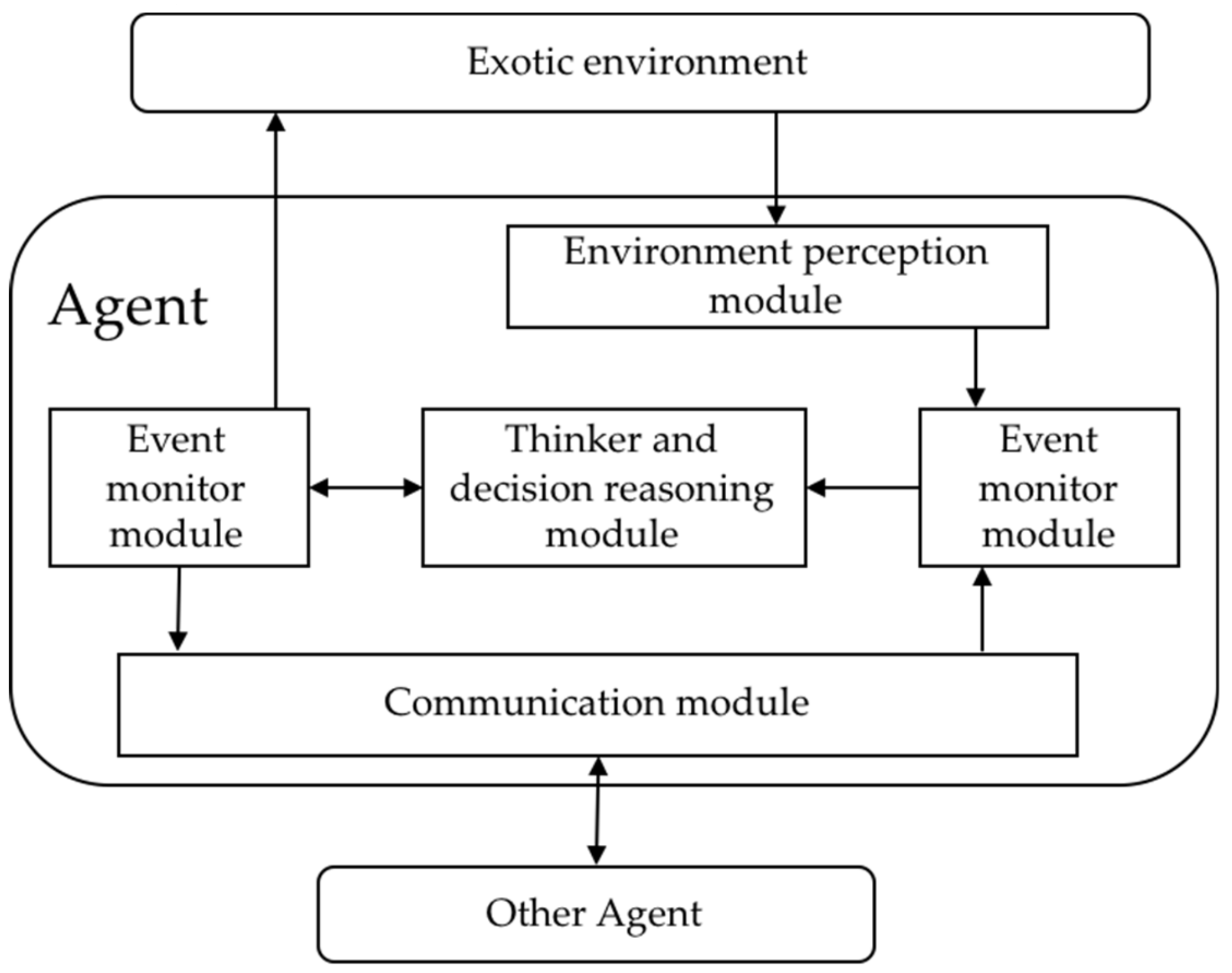
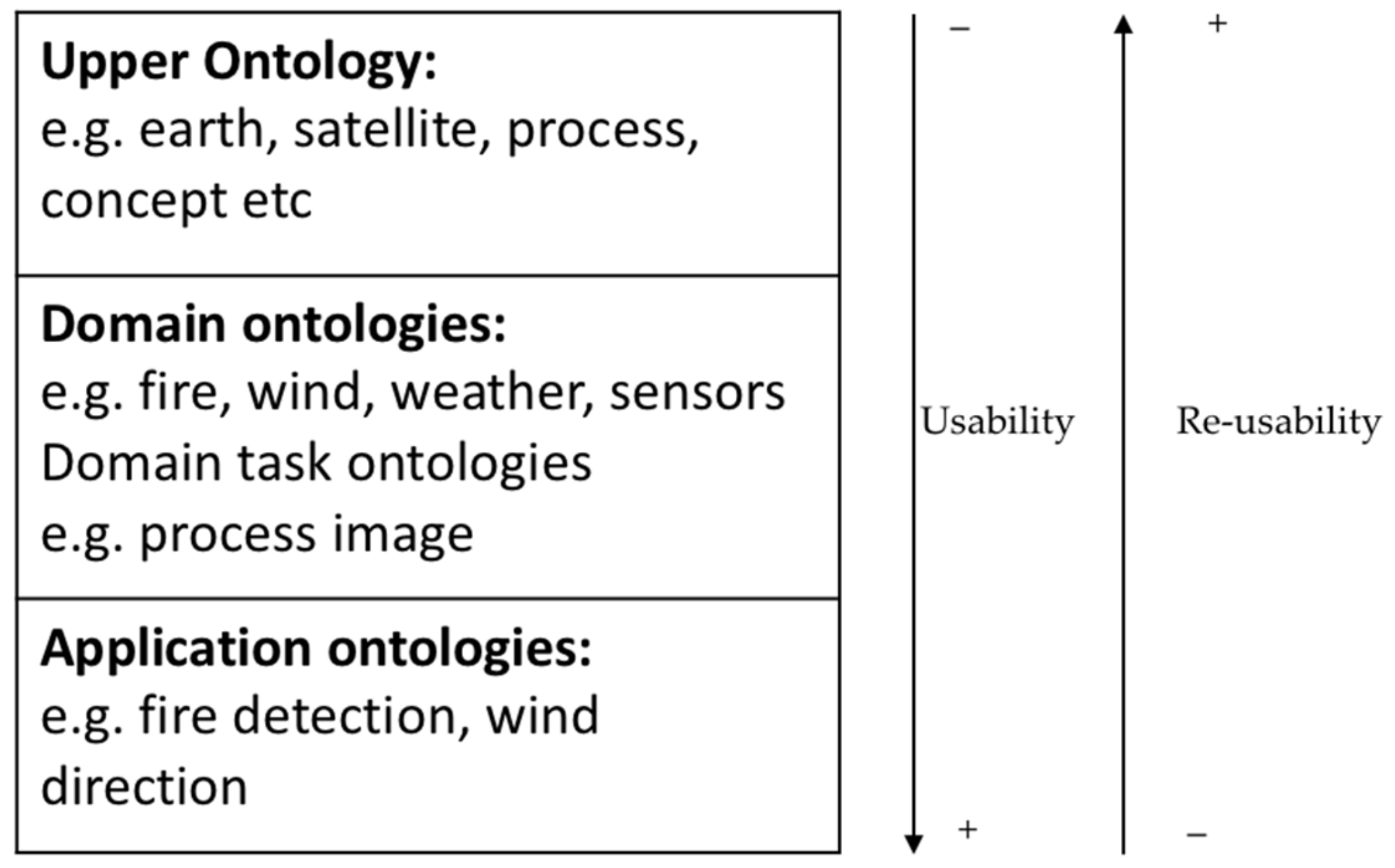
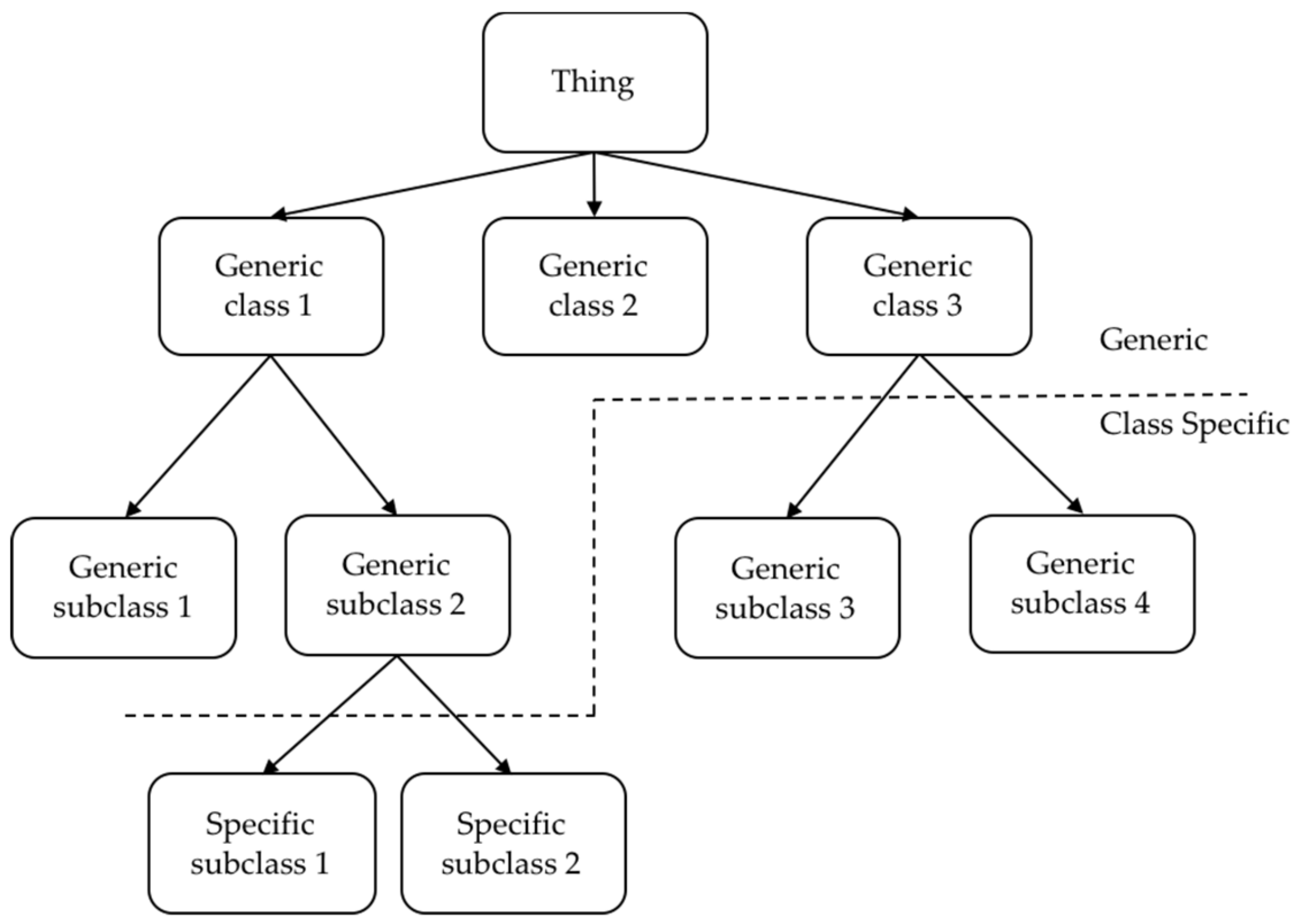
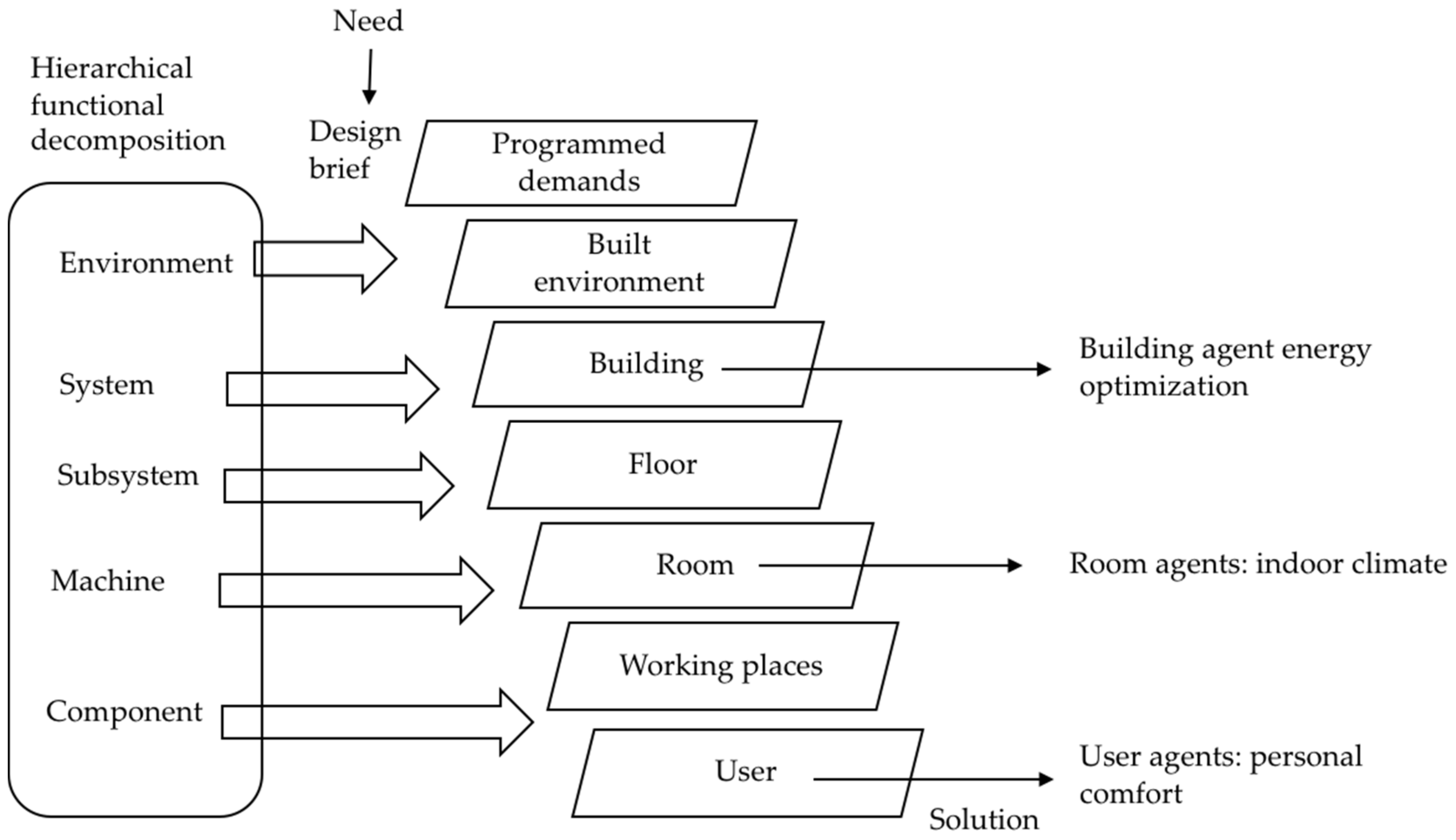
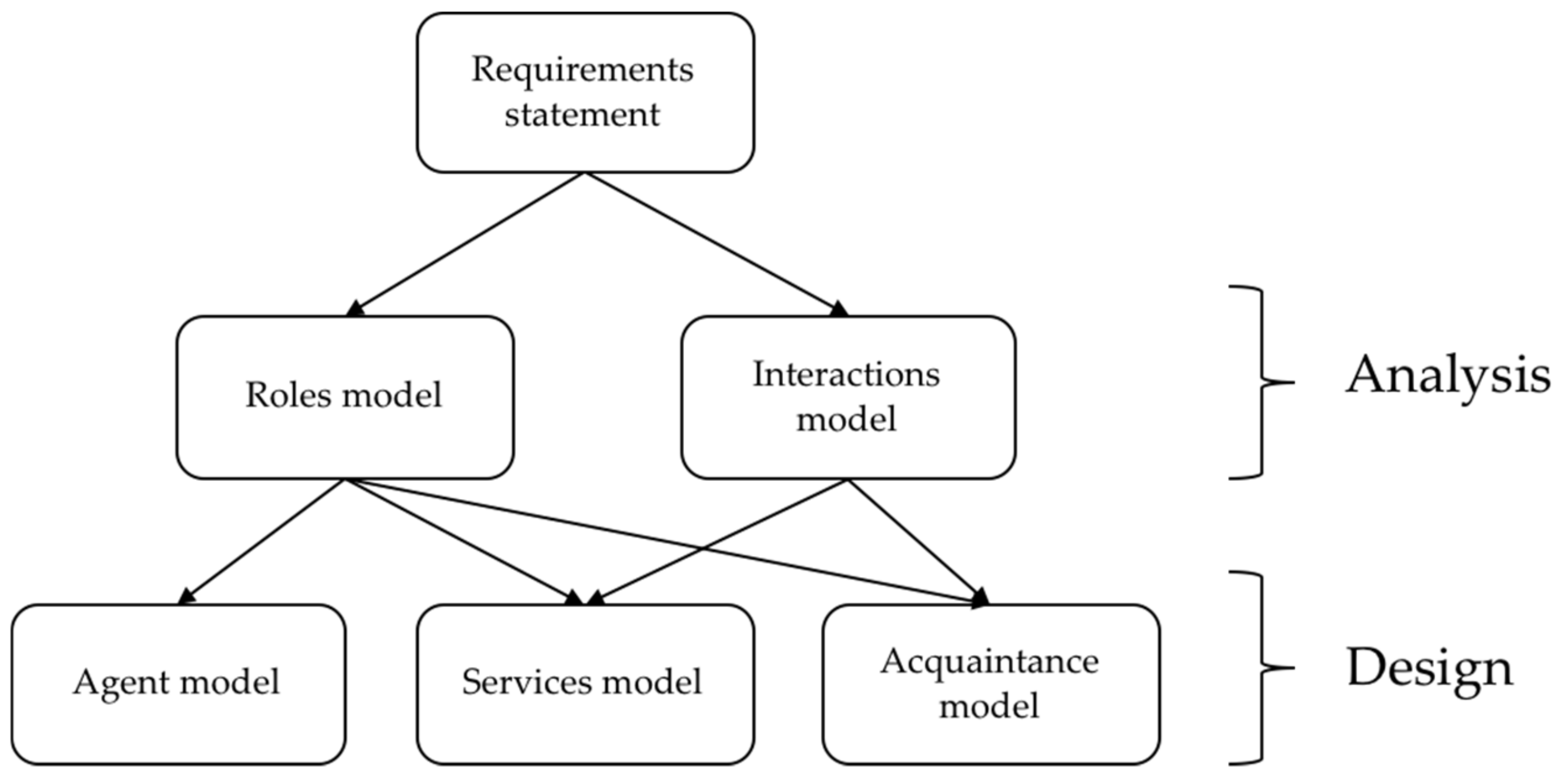
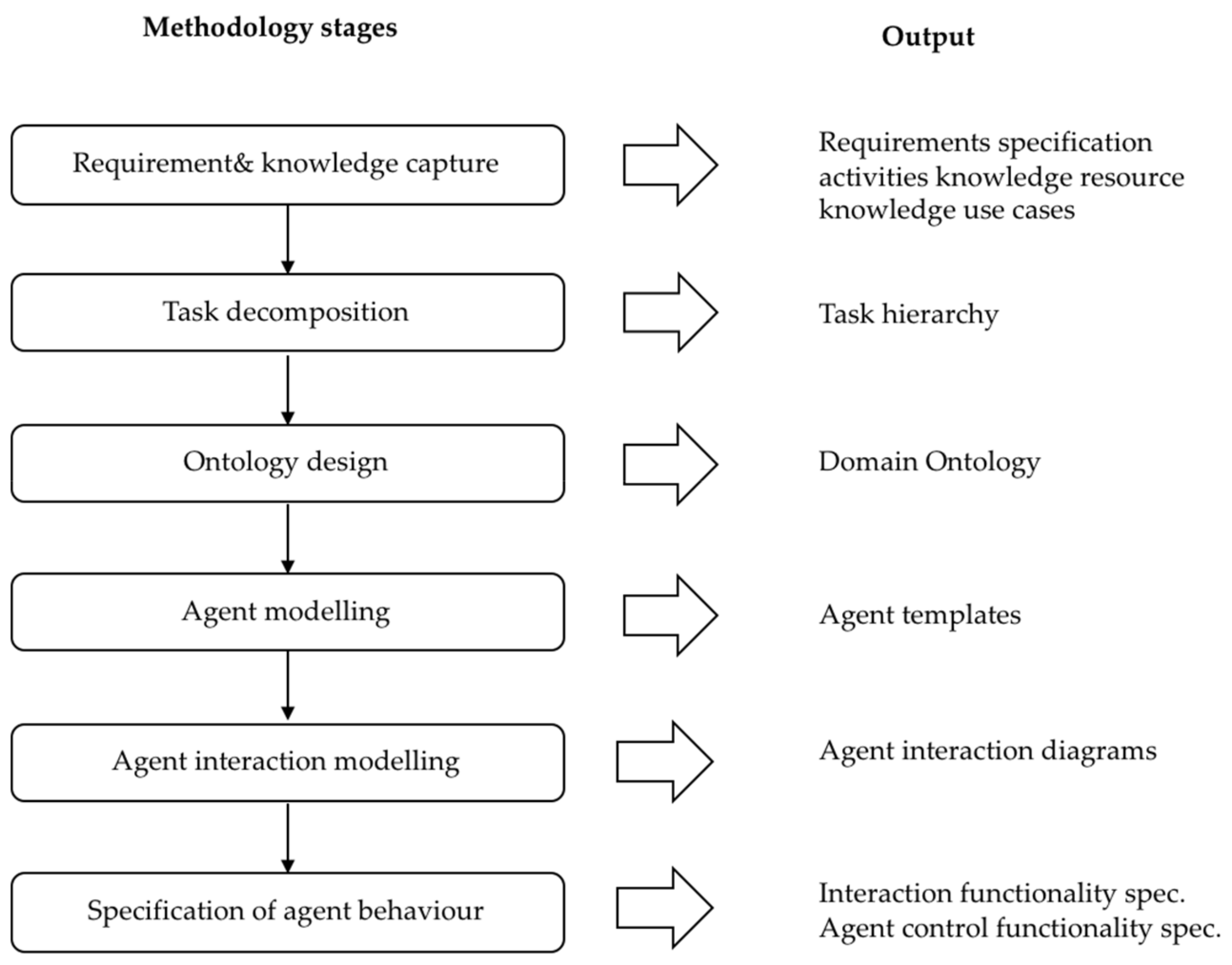
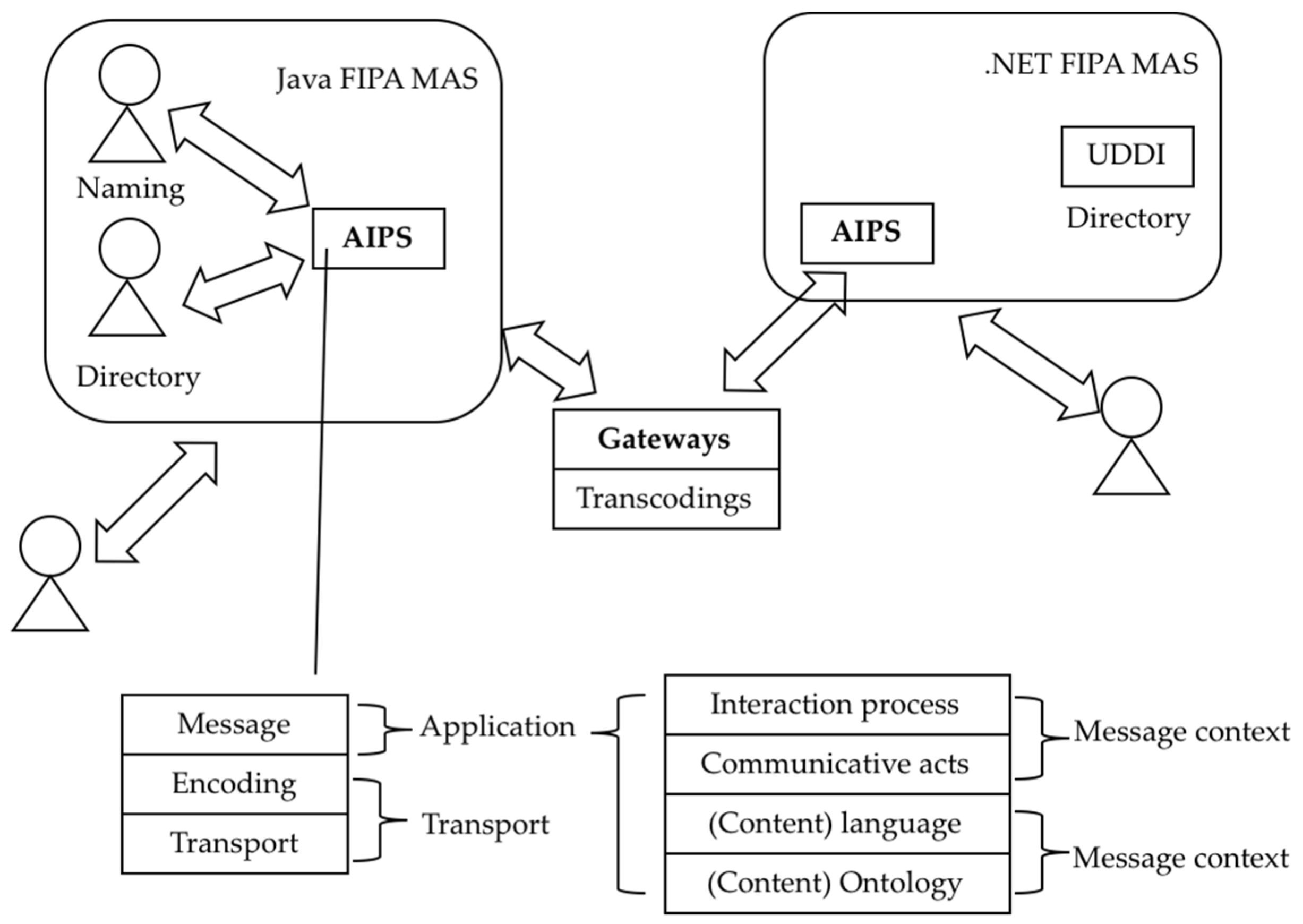

| Database | Result |
|---|---|
| Web of Science | 355 |
| IEEE | 822 |
| ScienceDirect | 58 |
| ACM | 198 |
| Total | 1433 |
| Grid Control | Power System | Energy Management System | Microgrid | Buildings/Demand Side | Electricity Market |
|---|---|---|---|---|---|
| 8 | 3 | 2 | 3 | 5 | 6 |
© 2019 by the authors. Licensee MDPI, Basel, Switzerland. This article is an open access article distributed under the terms and conditions of the Creative Commons Attribution (CC BY) license (http://creativecommons.org/licenses/by/4.0/).
Share and Cite
Ma, Z.; Schultz, M.J.; Christensen, K.; Værbak, M.; Demazeau, Y.; Jørgensen, B.N. The Application of Ontologies in Multi-Agent Systems in the Energy Sector: A Scoping Review. Energies 2019, 12, 3200. https://doi.org/10.3390/en12163200
Ma Z, Schultz MJ, Christensen K, Værbak M, Demazeau Y, Jørgensen BN. The Application of Ontologies in Multi-Agent Systems in the Energy Sector: A Scoping Review. Energies. 2019; 12(16):3200. https://doi.org/10.3390/en12163200
Chicago/Turabian StyleMa, Zheng, Mette Jessen Schultz, Kristoffer Christensen, Magnus Værbak, Yves Demazeau, and Bo Nørregaard Jørgensen. 2019. "The Application of Ontologies in Multi-Agent Systems in the Energy Sector: A Scoping Review" Energies 12, no. 16: 3200. https://doi.org/10.3390/en12163200
APA StyleMa, Z., Schultz, M. J., Christensen, K., Værbak, M., Demazeau, Y., & Jørgensen, B. N. (2019). The Application of Ontologies in Multi-Agent Systems in the Energy Sector: A Scoping Review. Energies, 12(16), 3200. https://doi.org/10.3390/en12163200






